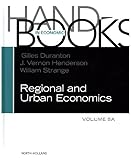Handbook of regional and urban economics, vol 5a / Gilles Duranton, Vernon Henderson, William Strange.
Material type: TextPublisher: Boston, MA : Elsevier, 2015Description: xix, 698 pages : illustrations ; 24 cmContent type:
TextPublisher: Boston, MA : Elsevier, 2015Description: xix, 698 pages : illustrations ; 24 cmContent type: - text
- unmediated
- volume
- 9780444595171 (hbk.)
- 23 330.91732 HAN 010798
| Item type | Current library | Call number | Status | Date due | Barcode |
|---|---|---|---|---|---|
 Book
Book
|
Indian Institute for Human Settlements, Bangalore | 330.91732 HAN 010798 (Browse shelf(Opens below)) | Available | 010798 |
Includes bibliographical references and index.
Front Cover; Handbook of Regional and Urban Economics; Copyright; Introduction to the series; Contents; Foreword; Contributors; Section I: Empirical Methods; Chapter 1: Causal Inference in Urban and Regional Economics; 1.1. Introduction; 1.2. A Framework for Empirical Investigation; 1.2.1. A binary treatment environment; 1.2.2. A taxonomy of treatment effects; 1.2.3. Continuous treatments; 1.2.4. Randomization; 1.3. Spatial Aggregation; 1.4. Selection on Observables; 1.4.1. Fixed effects methods; 1.4.2. Difference in differences methods; 1.4.3. Matching methods; 1.5. IV Estimators.
1.5.1. Foundations1.5.2. Examples of IV in urban economics; 1.6. Regression Discontinuity; 1.6.1. Basic framework and interpretation; 1.6.2. Implementation; 1.6.3. Examples of RD in urban economics; 1.7. Conclusion; References; Chapter 2: Structural Estimation in Urban Economics; 2.1. An Introduction to Structural Estimation; 2.1.1. Model selection and development; 2.1.2. Identification and estimation; 2.1.3. Policy analysis; 2.1.4. Applications; 2.2. Revealed Preference Models of Residential Choice; 2.3. Fiscal Competition and Public Good Provision; 2.3.1. Theory.
2.3.1.1. Preferences and heterogeneity2.3.1.2. Household sorting; 2.3.1.3. Community size, housing markets, and budgets; 2.3.1.4. Equilibrium; 2.3.1.5. Properties of equilibrium; 2.3.1.6. Computation of equilibrium; 2.3.1.7. Extensions; 2.3.2. Identification and estimation; 2.3.2.1. The information set of the econometrician; 2.3.2.2. Predictions of the model; 2.3.2.3. Household sorting by income; 2.3.2.4. Public good provision; 2.3.2.5. Voting; 2.3.2.6. Identifying and estimating housing supply functions; 2.3.3. Policy analysis; 2.3.3.1. Evaluating regulatory programs: the Clean Air Act.
2.3.3.2. Decentralization versus centralization2.4. The Allocation of Economic Activity Across Space; 2.4.1. Specialization of regions; 2.4.1.1. Model development; 2.4.1.2. Estimation and identification; 2.4.2. Internal structure of cities; 2.4.2.1. Model development; 2.4.2.2. Estimation and identification; 2.4.3. Policy analysis; 2.4.4. Relation to entry models in the industrial organization literature; 2.5. Conclusions; References; Chapter 3: Spatial Methods; 3.1. Introduction; 3.2. Nonrandomness in Spatial Data; 3.3. Spatial Models; 3.3.1. Specification of linear spatial models.
3.3.2. Specifying the interconnections3.3.3. Interpretation; 3.3.3.1. Spatial versus social interactions; 3.3.3.2. Pecuniary versus technological externalities; 3.4. Identification; 3.4.1. Spatially autocorrelated unobservables, when these are uncorrelated with the observables; 3.4.1.1. The reflection problem; 3.4.1.2. Solutions to the reflection problem; 3.4.2. Spatially autocorrelated unobservables, when these are correlated with the observables; 3.4.3. Sorting and spatial unobservables; 3.4.4. Spatial methods and identification.
Front Cover; Handbook of Regional and Urban Economics; Copyright ; Introduction to the series; Contents; Foreword; Contributors; Section III: Housing and Real Estate; Chapter 11: Housing Bubbles; 11.1. Introduction; 11.2. The Linear Asset Pricing Model and the Idiosyncrasies of Housing; 11.2.1. The linear asset pricing model or user cost model; 11.2.2. Processes with momentum, mean reversion and stochastic growth rates; 11.2.3. What is special about housing?; 11.2.4. Directions for future research; 11.3. Empirical Regularities of Housing Dynamics; 11.3.1. Excess variance.
11.3.2. The shape of the cycle: short run momentum and long run mean reversion11.3.3. Quantities versus prices; 11.3.4. Bubbles in history; 11.3.5. Directions for future research; 11.4. Rationalizing the Seemingly Irrational: Search, Heterogeneity and Agency Problems in Credit Markets; 11.4.1. Search, learning, and momentum; 11.4.2. Changes in credit conditions; 11.4.3. Agency, underpriced default options and rational bubbles; 11.4.4. Directions for future research; 11.5. A Menagerie of Modest Madness: Bounded Rationality and Housing Markets.
11.5.1. Exogenous and heterogeneous beliefs: search, endogenous housing supply, and land acquisition11.5.2. Extrapolative beliefs; 11.5.3. Cognitive limitations: natural expectations, spatial benchmarking, and rule-of-thumb spending; 11.5.4. Social learning and the entrepreneurs of error; 11.5.5. Directions for future research; 11.6. Public Policy and Bubbles; 11.7. Conclusion; Acknowledgments ; References; Chapter 12: Housing, Finance, and the Macroeconomy; 12.1. Introduction; 12.2. Stylized Facts; 12.2.1. Levels of aggregates; 12.2.2. Cross-sectional facts.
12.2.3. Volatilities and correlations12.3. Housing and the Business Cycle; 12.4. Housing over the Life Cycle and in the Portfolio; 12.4.1. A typical model; 12.4.1.1. Utility; 12.4.1.2. Choices; 12.4.1.3. Constraints; 12.4.1.4. Expectations for wages and prices; 12.4.2. Calibration and estimation; 12.4.3. Major findings in the portfolio literature; 12.4.3.1. Housing and consumption patterns over the life cycle; 12.4.3.1.1. Home ownership over the life cycle; 12.4.3.1.2. Housing collateral to smooth consumption; 12.4.3.1.3. House price risk and demand for housing.
12.4.3.2. The role of housing in the financial portfolio12.4.3.2.1. Introducing geography; 12.4.3.3. Mortgage choice; 12.5. Housing and Asset Pricing; 12.5.1. Representative agent model; 12.5.2. Risk sharing with housing collateral; 12.6. The Housing Boom and Bust and the Great Recession; 12.6.1. Exogenous house prices, no default; 12.6.2. Exogenous house prices with default; 12.6.3. Endogenous house prices, no default; 12.6.4. Endogenous house prices with default; 12.7. Housing Policy; 12.7.1. Mortgage interest rate deductibility; 12.7.2. Housing finance intermediaries.
Developments in methodologies, agglomeration, and a range of applied issues have characterized recent advances in regional and urban studies. Volume 5 concentrates on these developments while treating traditional subjects such as housing, the costs and benefits of cities, and policy issues beyond regional inequalities. Contributors make a habit of combining theory and empirics in each chapter, guiding research amid a trend in applied economics towards structural and quasi-experimental approaches. Clearly distinguished from the New Economic Geography covered by Volume 4, these articles feature.


There are no comments on this title.